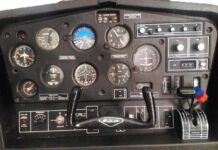Can I Really Do That?
I read with amazement Paul Bertorelli’s sidebar regarding “IFR in Class G Airspace” in the June issue.
Just so I’m clear on this…I can file an IFR flight plan, climb into my plane at a non-towered airport which lies within Class G airspace, fire it up and climb out into the “clag” (without a clearance from ATC) as long as I remain clear of controlled airspace until calling ATC and receiving my clearance from them and this is legal?
Jeff Willwerth
Dublin, CA
Yup. Also, in the unlikely scenario of you remaining entirely in Class G airspace, you need not even have filed for an IFR clearance. You’re IMC in uncontrolled airspace and don’t need a clearance.
Strange, but true. Of course, legal doesn’t necessarily mean smart or safe.
Which Liberal Runway Is That?
June’s quiz using a “sequestered” approach chart was quite clever, but I think you got the first answer wrong. You ask, “Which runway does this approach serve?” Since this ILS lists circling minima, it serves all runways, not just the title runway 35.
And what about that cheap shot at liberals? The sequester was passed by both houses of Congress, including the “conservative” one.
Paul R. Sergeant, CFII
Allen, Texas
OK, you’re right. To be completely correct, we should have asked the question, “What’s the primary runway for this approach?”
We disagree that it was a cheap shot because the only comment made was, “Where else would you find a sequestered approach than Liberal, Kansas?”
Lee Smith puts together our routine monthly quizzes. He responds, “There was no political commentary intended. Liberal, being in America’s heartland, with the mere word having government and political overtones, in my mind, simply suggested it as a whimsical choice for this quiz. There was no deliberate attempt to express a political view one way or another.
“Besides, there’s no town named ‘Conservative’ with an airport. I checked. Perhaps I should have used Reagan Int’l?”
That said, Paul, in the future we’ll make a greater effort to avoid misunderstandings like this.
No Tower, No Problem
I enjoyed “No Tower, No Problem” in the June issue. I’d add that when you’re on the ground requesting an IFR clearance from an non-towered airport you should also specify your departure runway. “N3AB, on the ground at Chester County, departing runway 22 and requesting IFR clearance to Danbury”.
Earl H. Scott
Marietta, Georgia
Good point, Earl. While I’ve heard and been given clearances at non-towered airports that do not request a departure runway, they often do ask and it’s good form to provide it. I think it’s doubly important to specify the departure runway when getting a clearance through FSS as the middleman communications can be very cumbersome if there is a dialog required.
I read with interest Tarrance Kramer’s article on IFR operations at non-towered airports in the June issue. It brought back an IFR flight I made a few years ago from a non-towered airport.
I got my clearance and was told to hold for release as a King Air was on approach. After watching my fuel reserves diminish for what seemed like an eternity I saw the King Air land. I told ATC that the King Air was on the ground. ATC said they could not release me until the King Air canceled.
I was monitoring Unicom and heard the King Air pilot in a lengthy conversion with the FBO about not having his passenger’s limo on the ramp. I asked the pilot if he could please cancel and his response was that he would cancel went he was [expletive] well ready.
Needless to say non-towered operations work better when pilots show some courtesy and promptly cancelling an IFR clearance once on the ground should be at the top of the list.
Joe Palazzi,
Chester, Connecticut
You’re right that we’ll need to be more cognizant of the need to cancel IFR as soon as possible, but we also have to be careful not to cancel too early. It’s easy to drop out of the muck, see the airport and immediately cancel, not remembering that we’ve not yet achieved the requisite VFR clearance from clouds.
As for your rude pilot, well, pilots, like the rest of society, unfortunately come in courteous and rude versions.
Can You Hear Me Now?
I do not see any guidance in the AIM pertaining to radio failure procedures while VFR within Class B or Class C airspace.
Scenario: Assume a VFR aircraft in VMC and radio failure occurs after entering Class C or Class B.
The AIM provides a lot of related guidance, but doesn’t cover this particular circumstance. I understand the IFR procedures but what are the procedures when flying VFR (not on an IFR flight plan) in Class C and Class B?
Dan Chitty
Winston-Salem, North Carolina
Good question. There doesn’t seem to be a definitive answer. After considerable thought the consensus of those I did ask is that you behave as if you’re on an IFR flight plan.
Here’s why: Just like when on IFR, you’re under positive control in Class B and C. The controller is telling you exactly what to do, when and why. So, if you go NORDO, chances are high that he’ll assume you’ll do what you were last expected to do, even though you’re VFR. Remember, while VFR in Class B, you can’t just change your mind (altitude, heading, etc.) without telling them.
It gets a bit messier if you were planning a landing at a Class C airport and ATC already knows that. If there’s a clear and obvious non-towered alternative, I’d probably use that. But if not, I’d continue and land at the Class C airport. In either case, be sure to call them on the phone as soon as possible after landing. An interesting dialog will likely result after which you’ll both likely wish the other to have a better day.
Why DME and Radar?
I’m a flight instructor at the North Las Vegas Airport (VGT). One of the problems I have with training at VGT is that the ILS specifies that radar and DME are required.
When we train we use a VFR GPS in the panel for DME, but when it comes to the check ride or even that infrequent actual approach, we must go to LAS for a VOR and ILS approach that don’t require DME. Why do they require radar and DME and make our lives so difficult?
Scott Brooksby
Las Vegas, Nevada
DME and Radar aren’t required for the actual ILS approach. In fact, DME can’t be required for the ILS per TERPS paragraph 161a: “ILS procedures do not require DME to fly the final approach, even if a DME fix has been substituted for one of the marker beacons, therefore, ILS procedures shall not be named ILS/DME.”
So why are radar and DME required here? You need radar vectors to get on the approach and DME for any step-downs that can’t be called by radar. You need DME for the missed approach procedure, but you might be able to get ATC to give you alternate missed approach instructions without a DME requirement. With both of those, the approach would be legal (even in IMC) without DME.
Now, convincing your local inspectors they are wrong—and getting them to admit that—may be too much to ask.
We don’t answer everything, but we do read ‘em all. Send anything but offers of Nigerian bank transfers to [email protected]. Please include your full name and location.




